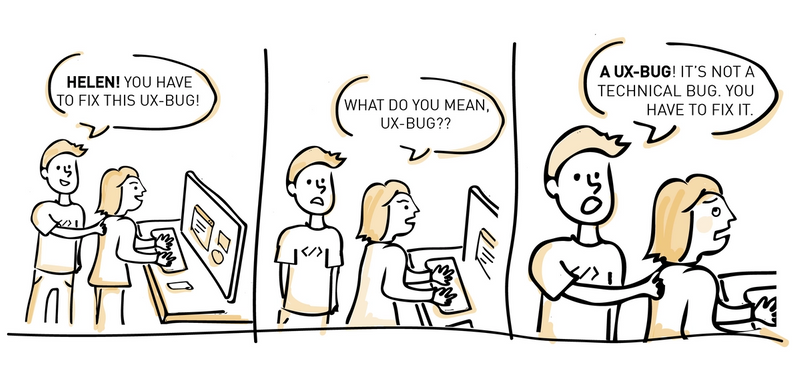The world premiere of UX.christmas
Tada. With this post, I declare UX.christmas hereby launched. Welcome to the world’s first UX advent calendar from Bekk – 24 articles from 24 Bekkers and a rant about roles and tunnel vision.
5 min read
·
By Helen Le
·
December 1, 2019
But first, some context.
What can one expect from a UX advent calendar from Bekk? UX.christmas is a collaborative project where 24 writers have written as many articles, full of industry-relevant tidbits. The “windows” of this advent calendar cover a variety of topics like creativity, storytelling, and product development. Everything from variable fonts and dark patterns (on Friday the 13th of course 👻) to hypothesis testing and digital accessibility.
Some articles are written in English, and some in Norwegian. They are just short enough (2-3 minute read) to squeeze in on the way to work or while you wait for the gingerbread to bake in the oven. But if that isn’t enough to scratch your itch this advent, you can always try out a window on one of the 11 (!) other calendars Bekk is publishing this holiday season. Check out bekk.christmas to see them all.
Here are a couple of sneak previews of what you can come to expect from UX.christmas:\ \ December 4th: Designer Sonja Porter has a wake-up call when it comes to Maslow’s Hierarchy of Needs...
"“Way back in 1943 Abraham Maslow published his “Hierarchy of needs” – a pyramid describing the forces that motivate us, and the order in which we strive to meet them. For many designers, this 76-year-old model still informs the design decisions we make every day. But did you know that Maslow moved on to an updated model only a few years later? Or that psychologists stopped using Maslow’s pyramid years ago?“"
\ December 6th: Copywriter Erik Mathisen tells us a little story on storytelling (in Norwegian) …
"“Historier sender ungene våre til drømmeland. Historier bygger solide merkevarer og får tårer til å trille på kino. Historier skaper helter. Skurker. Presidenter. Mytologier. Konspirasjoner. Legender.
Historier er sentrale i vår fortløpende konstruksjon av virkeligheten.
De er limet som skaper et fornuftig narrativ vi kan forholde oss til i dag, i morgen og til dagen historiene våre er alt som er igjen.
Velkommen til en liten historietime. Om historier.“"
Roles and tunnel vision
This year, a couple of us in Bekk’s Interactive department decided to make our own UX advent calendar to compliment the slurry of development calendars produced by the Technology department. Only a breath or two later, a discussion arose about what it would be called and what type of articles we should include. Is “UX” the right term? Does it cover all of the specialities we have in our discipline?
In our industry, there are a ton of titles and role-descriptions for what we do. In Bekk we have Graphic Designers, Interaction Designers, Service Designers, UX Designers, Product Designers, Product Developers, Front-end Developers, Full-stack Developers, and Project Managers to name a few.
These titles make it easy to distinguish between practice areas and foster expertise within our own discipline. They make it easy to identify individuals, assign responsibility within a team, and assure cross-disciplinary collaboration. My experience is that the titles can also create silos and disclaimers within the team.
Interaction Designers facilitate user testing and create user-flows. Visual or Graphic Designers focus on combining visuals and other elements to create clear communication, and developers make sure that the technology delivers. It’s natural for us to want to keep to our own camp and focus on problems that can be solved with our own discipline. But this tunnel vision can severely limit our creative thinking and force us to fall back on obvious solutions.
Being true to your discipline does not always have to be the golden standard. That super-important insight workshop and user test you’ve been planning maybe isn’t the best for your agile team and could hinder other important priorities. Even if you are the design expert in the room, that doesn’t necessarily mean that you have the correct answer when it comes to users, or that you know what is important to prioritise right now.
Who is actually responsible for user experience?
What if the whole team, no matter their background, was more curious about each other's work? Expand your horizons – co-design with a product owner. Practice style and tone of voice with a developer. Take over the customer service lines for a day, or try your hand at in-browser coding. Look past titles and figure out what your teammates are doing. At the end of the day, we are all working together to achieve the same thing (hopefully). By erasing our roles, the whole team can work towards a common goal: the best product for our users. Let the whole team take responsibility and feel ownership of the user experience – not just their own discipline.
A true story:

Everyone is a UXer.
Titles can so easily put us in a box. But why can’t a developer think about tone of voice, while a Visual Designer considers technical architecture and implementation. Just to be clear, I'm not saying that designers should take over and code. By putting titles to the side, a team can collaborate and focus on what they want to achieve. We should be open, challenge one another, not micromanage eachother or cling on to the methods we learned in school. Do we really need these titles, as long as we are delivering value?
Happy December 1st! Thanks for opening the first window of our advent calendar. Remember to follow along for a new design tidbit every day until Christmas Eve.
Helen Le\ – Innovator of Interaction Interpretation & UX.christmas-pusher
Up next...
Loading…
Loading…
Loading…